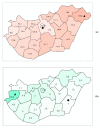Prescribing Patterns and Variations of Antibiotic Use for Children in Ambulatory Care: A Nationwide Study
- PMID: 35203792
- PMCID: PMC8868088
- DOI: 10.3390/antibiotics11020189
Prescribing Patterns and Variations of Antibiotic Use for Children in Ambulatory Care: A Nationwide Study
Abstract
The aim of this study was to analyse characteristics of paediatric antibiotic use in ambulatory care in Hungary. Data on antibiotics for systemic use dispensed to children (0-19 years) were retrieved from the National Health Insurance Fund. Prescribers were categorised by age and specialty. Antibiotic use was expressed as the number of prescriptions/100 children/year or month. For quality assessment, the broad per narrow (B/N) ratio was calculated as defined by the European Surveillance of Antimicrobial Consumption (ESAC) network. Paediatric antibiotic exposure was 108.28 antibiotic prescriptions/100 children/year and was the highest in the age group 0-4 years. Sex differences had heterogenous patterns across age groups. The majority of prescriptions were issued by primary care paediatricians (PCP). The use of broad-spectrum agents dominated, co-amoxiclav alone being responsible for almost one-third of paediatric antibiotic use. Elderly physicians tended to prescribe less broad-spectrum agents. Seasonal variation was found to be substantial: antibiotic prescribing peaked in January with 16.6 prescriptions/100 children/month, while it was the lowest in July with 4 prescriptions/100 children/month. Regional variation was prominent with an increasing west to east gradient (max: 175.6, min: 63.8 prescriptions/100 children/year). The identified characteristics of paediatric antibiotic use suggest that prescribing practice should be improved.
Keywords: antibiotic exposure; antibiotic stewardship; drug utilisation study; number of prescriptions; outpatient use; physician specialty; prescription rate; public health; regional variation; seasonality.
Conflict of interest statement
The authors declare no conflict of interest.
Figures



References
-
- World Health Organization (WHO) Antimicrobial Resistance. [(accessed on 27 July 2019)]. n.d. Available online: https://www.who.int/news-room/fact-sheets/detail/antimicrobial-resistance.
-
- World Health Organization (WHO) Guidelines on prudent use of antimicrobials. [(accessed on 27 July 2019)]. n.d. Available online: https://www.euro.who.int/en/health-topics/disease-prevention/antimicrobi....
-
- European Centre for Disease Prevention and Control (ECDC) Annual Epidemiological Report for 2017. ECDC; Stockholm, Sweden: 2018. Antimicrobial consumption.
-
- World Health Organization (WHO) WHO Collaborationg Centre for Drug Statistics Methodology. Definition and general considerations. [(accessed on 27 July 2019)]. n.d. Available online: https://www.whocc.no/ddd/definition_and_general_considera.
LinkOut - more resources
Full Text Sources

